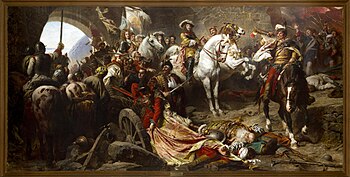Battle of Buda (1686)
| Second Siege of Buda, 1686 | |||||||
|---|---|---|---|---|---|---|---|
| Part of Great Turkish War | |||||||
 The Recapture of Buda Castle in 1686 by Gyula Benczúr |
|||||||
|
|||||||
| Belligerents | |||||||
| Holy League |
|
||||||
| Commanders and leaders | |||||||
|
Charles V, Duke of Lorraine Louis William, Margrave of Baden-Baden Ernst Rüdiger von Starhemberg |
Abdurrahman Abdi Arnavut † Grand Vizier Sarı Süleyman Paşa Pasha of Temeşvar Pasha of İstolni Belgrad Pasha of Osijek |
||||||
| Strength | |||||||
| 65,000—100,000 | Garrison below 7,000 men inside Buda (including 3,000 Janissaries, 1,000 horses, 1,000 Jews and 2,000 inhabitants | ||||||
| Casualties and losses | |||||||
| 24,000—30,000 | 3,000 killed 6,000 captured (including civilians) |
||||||
The Battle of Buda (1686) was fought between the Holy League and the Ottoman Empire, as part of the follow-up campaign in Hungary after the Battle of Vienna. The Holy League took Buda after a long siege.
In 1541 Buda was conquered by the Turks in the Siege of Buda, and was under Ottoman rule for the next 145 years. The economic decline of Buda the capital city during the Ottoman conquest characterized by the stagnation of population, the population of Buda was not larger in 1686, than the population of the city two centuries earlier in the 15th century. The Ottomans allowed the Hungarian royal palace to fall into ruins. The amortized palace was later transformed into a gunpowder storage and magazine by the Ottomans, which caused its detonation during the siege in 1686. The original Christian Hungarian population didn't feel secure during the Ottoman conquest, their numbers significantly shrank in the next decades, due to their fleeing to the Habsburg ruled Royal Hungary. The number of Jews and Gypsy immigrants became dominant during the Ottoman rule in Buda. It became an Ottoman cultural and commercial center. Some of the churches in the city were rebuilt as mosques rather than being destroyed. Churches, mosques, schools, communal kitchens, bakeries and Turkish baths were built.
Following the Ottoman failure in the Second Siege of Vienna, which started the Great Turkish War, Emperor Leopold I saw the opportunity for a counter-strike and the re-conquest of Hungary, so that the Hungarian capital Buda could be regained from the Ottomans. With the aid of Pope Innocent XI, the Holy League was formed on 5 March 1684, with King Jan Sobieski of Poland, Emperor Leopold I and the Republic of Venice agreeing to an alliance against the Turks.
...
Wikipedia
